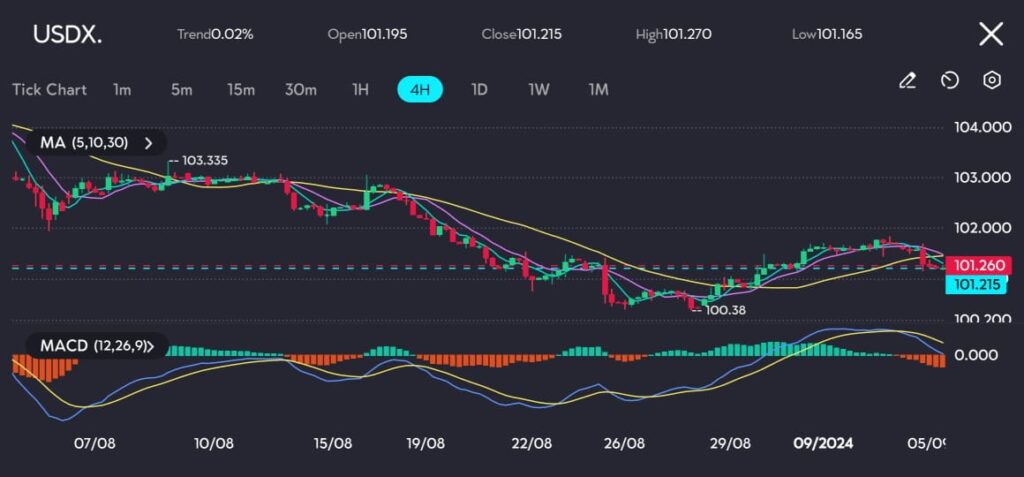Key points:
- Traders increase bets on a 50-basis-point rate cut, pushing the dollar lower.
- Safe-haven currencies like the yen and Swiss franc gain amid concerns over U.S. economic growth.
The U.S. dollar dipped on Thursday as traders raised their expectations of an outsized rate cut from the Federal Reserve later this month. Concerns over the U.S. economy’s growth outlook, following weaker-than-expected data, have pushed investors toward safe-haven currencies like the yen.
This shift comes as global markets remain tense, with stocks showing losses as the growth outlook for the world’s largest economy looks less promising than initially expected.
Concerns over U.S. economic slowdown drive shift to safe-haven currencies

See: Dollar index dips, trading at 101.260 as seen on the VT Markets app.
Looking at the charts, the U.S. Dollar Index (USDX) saw some sideways movement, closing at 101.215 after reaching a high of 101.270 and a low of 101.165. The 4-hour chart reflects a minor uptick in volatility as the price remains trapped between the 100.38 support level and the 102.00 resistance zone.
The 5, 10, and 30-period moving averages indicate some pressure towards the downside, while the MACD histogram suggests waning bullish momentum, with the MACD and signal lines nearing a crossover, indicating potential further weakness.
Recent weak U.S. data, including the fall in job openings to a 3.5-year low, has heightened concerns about the robustness of the U.S. labour market. This, in turn, has raised speculation that the Federal Reserve could lean towards a more dovish stance in its upcoming monetary policy meeting.
Immediate resistance remains at 102.00, and support is observed at the recent low of 100.38. A break above the resistance could see the dollar index aim for higher levels around 103.30, but a failure to hold the 100.38 support could send the index lower, potentially testing the 100.00 mark.
These figures followed Tuesday’s ISM manufacturing survey, which remained in contraction territory, further fuelling fears that the U.S. economy may be slowing more sharply.
Traders have responded by reducing exposure to riskier assets and seeking safety in currencies such as the Japanese yen and Swiss franc.
The yen emerged as the strongest performer, gaining 0.26% to 143.56 per dollar, bringing its weekly gains to nearly 2%. The Swiss franc, another traditional safe-haven currency, remained steady at 0.8461 per dollar, posting a weekly gain of 0.46%. In comparison, the franc’s rise has been more subdued than that of the yen, reflecting different investor sentiments toward these two currencies.
You might be interested: Safe-haven yen rallies, Aussie sinks as U.S. payrolls test approaches
Fed rate cut speculation grows as labour market pressures ease
For the Fed, the recent data suggests that the labour market is no longer a source of inflationary pressure. This shift may justify a rate cut, with traders now pricing in a 44% chance of a 50-basis-point reduction when the Federal Reserve meets later this month, up from 38% just a week ago.
While the dollar remained weak, other major currencies like the euro and sterling showed little change, with the euro steady at $1.1083 and sterling at $1.3147. The dollar index, which measures the greenback against a basket of currencies, fell slightly to 101.25.
All eyes are now on Friday’s nonfarm payrolls report. Expectations are that the U.S. economy will have added 160,000 jobs in August, compared with July’s increase of 114,000. The unemployment rate is forecast to ease slightly to 4.2%.
In other currency movements, risk-sensitive currencies like the Australian and New Zealand dollars struggled amid the global risk-off sentiment. The Australian dollar fell 0.15% to $0.67155, while the New Zealand dollar dropped 0.2% to $0.6186. These currencies, closely tied to global economic outlooks, have suffered as traders shift focus to safer assets.
You might be interested: Top 4 assets to inflation-proof your portfolio
As the market continues to digest economic data, the outcome of the Fed’s upcoming meeting and the nonfarm payrolls report will remain critical in determining the dollar’s path forward and the broader market’s risk sentiment.
Start trading now — click here to create your live VT Markets account.









